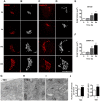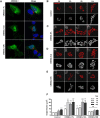CREB3L1-mediated functional and structural adaptation of the secretory pathway in hormone-stimulated thyroid cells
- PMID: 29093023
- PMCID: PMC6518157
- DOI: 10.1242/jcs.211102
CREB3L1-mediated functional and structural adaptation of the secretory pathway in hormone-stimulated thyroid cells
Abstract
Many secretory cells increase the synthesis and secretion of cargo proteins in response to specific stimuli. How cells couple increased cargo load with a coordinate rise in secretory capacity to ensure efficient transport is not well understood. We used thyroid cells stimulated with thyrotropin (TSH) to demonstrate a coordinate increase in the production of thyroid-specific cargo proteins and ER-Golgi transport factors, and a parallel expansion of the Golgi complex. TSH also increased expression of the CREB3L1 transcription factor, which alone caused amplified transport factor levels and Golgi enlargement. Furthermore, CREB3L1 potentiated the TSH-induced increase in Golgi volume. A dominant-negative CREB3L1 construct hampered the ability of TSH to induce Golgi expansion, implying that this transcription factor contributes to Golgi expansion. Our findings support a model in which CREB3L1 acts as a downstream effector of TSH to regulate the expression of cargo proteins, and simultaneously increases the synthesis of transport factors and the expansion of the Golgi to synchronize the rise in cargo load with the amplified capacity of the secretory pathway.
Keywords: CREB3L1; FRTL-5; Golgi; Membrane traffic; Secretory pathway; TSH.
© 2017. Published by The Company of Biologists Ltd.
Conflict of interest statement
Competing interestsThe authors declare no competing or financial interests.
Figures







Similar articles
-
Transcription Factor CREB3L1 Regulates the Expression of the Sodium/Iodide Symporter (NIS) in Rat Thyroid Follicular Cells.Cells. 2022 Apr 13;11(8):1314. doi: 10.3390/cells11081314. Cells. 2022. PMID: 35455992 Free PMC article.
-
Processing to endoglycosidase H-resistant thyrotropin subunits occurs in the presence of brefeldin-A: evidence favoring the recycling of Golgi membranes to the rough endoplasmic reticulum in mouse thyrotrophs.Thyroid. 1991;1(2):185-94. doi: 10.1089/thy.1991.1.185. Thyroid. 1991. PMID: 1822366
-
Transcription factors activated through RIP (regulated intramembrane proteolysis) and RAT (regulated alternative translocation).J Biol Chem. 2020 Jul 24;295(30):10271-10280. doi: 10.1074/jbc.REV120.012669. Epub 2020 Jun 2. J Biol Chem. 2020. PMID: 32487748 Free PMC article. Review.
-
Rab1b overexpression modifies Golgi size and gene expression in HeLa cells and modulates the thyrotrophin response in thyroid cells in culture.Mol Biol Cell. 2013 Mar;24(5):617-32. doi: 10.1091/mbc.E12-07-0530. Epub 2013 Jan 16. Mol Biol Cell. 2013. PMID: 23325787 Free PMC article.
-
The Regulatory Network of CREB3L1 and Its Roles in Physiological and Pathological Conditions.Int J Med Sci. 2024 Jan 1;21(1):123-136. doi: 10.7150/ijms.90189. eCollection 2024. Int J Med Sci. 2024. PMID: 38164349 Free PMC article. Review.
Cited by
-
Postnatal developmental trajectory of sex-biased gene expression in the mouse pituitary gland.Biol Sex Differ. 2022 Oct 11;13(1):57. doi: 10.1186/s13293-022-00467-7. Biol Sex Differ. 2022. PMID: 36221127 Free PMC article.
-
Lack of Nuclear Localization of the Creb3l1 Transcription Factor Causes Defects in Caudal Fin Bifurcation in Zebrafish Danio rerio.Cells Tissues Organs. 2025;214(2):77-95. doi: 10.1159/000540103. Epub 2024 Jul 17. Cells Tissues Organs. 2025. PMID: 38964305 Free PMC article.
-
A GBF1-Dependent Mechanism for Environmentally Responsive Regulation of ER-Golgi Transport.Dev Cell. 2019 Jun 3;49(5):786-801.e6. doi: 10.1016/j.devcel.2019.04.006. Epub 2019 May 2. Dev Cell. 2019. PMID: 31056345 Free PMC article.
-
Transcription factor Creb3l1 regulates the synthesis of prohormone convertase enzyme PC1/3 in endocrine cells.J Neuroendocrinol. 2020 Apr;32(4):e12851. doi: 10.1111/jne.12851. Epub 2020 Apr 21. J Neuroendocrinol. 2020. PMID: 32319174 Free PMC article.
-
Identification of dysregulated pathways underlying HTLV-1-associated myelopathy/tropical spastic paraparesis through co-expression network analysis.J Neurovirol. 2021 Dec;27(6):820-830. doi: 10.1007/s13365-020-00919-z. Epub 2021 Jan 6. J Neurovirol. 2021. PMID: 33405203
References
-
- Bonfanti L., Mironov A. A. Jr, Martínez-Menárguez J. A., Martella O., Fusella A., Baldassarre M., Buccione R., Geuze H. J., Mironov A. A. and Luini A. (1998). Procollagen traverses the Golgi stack without leaving the lumen of cisternae: evidence for cisternal maturation. Cell 95, 993-1003. 10.1016/S0092-8674(00)81723-7 - DOI - PubMed
MeSH terms
Substances
Grants and funding
LinkOut - more resources
Full Text Sources
Other Literature Sources

